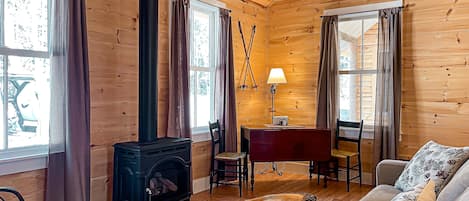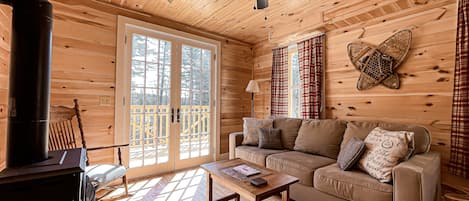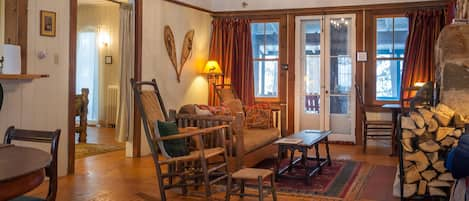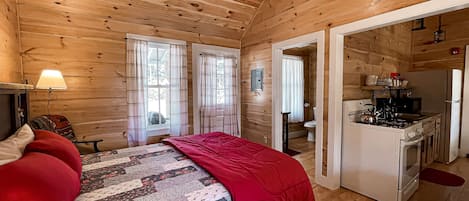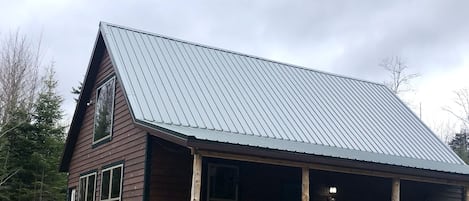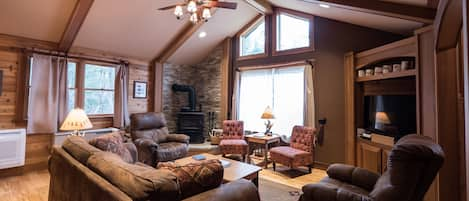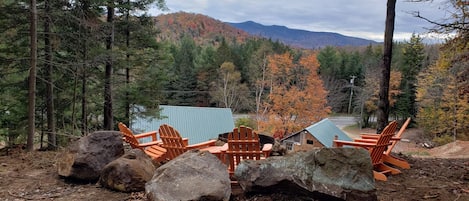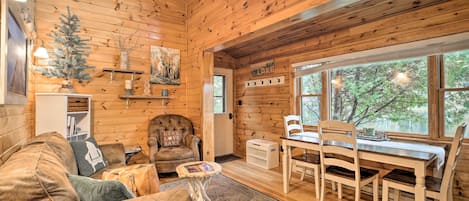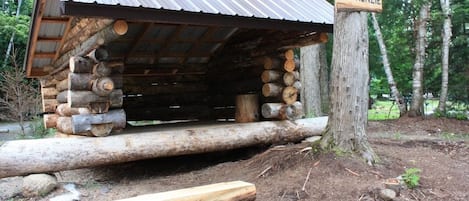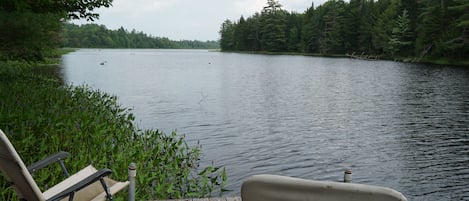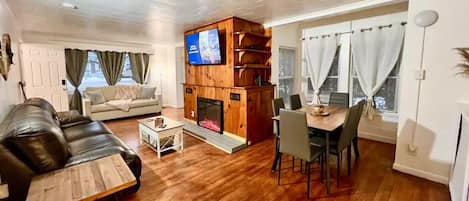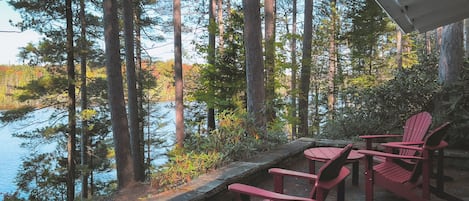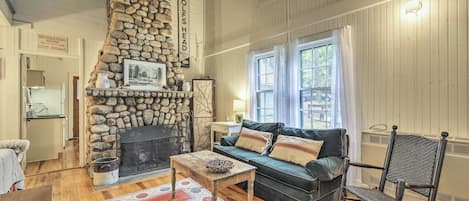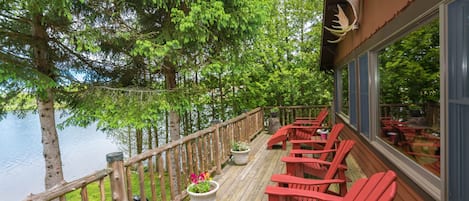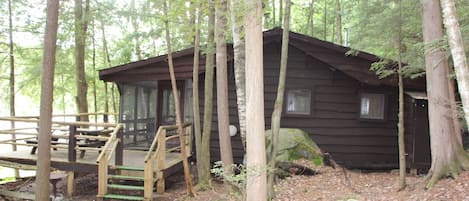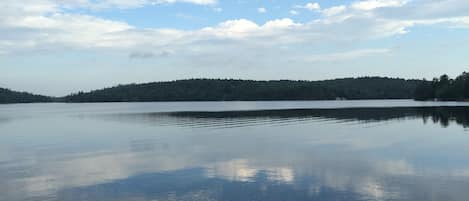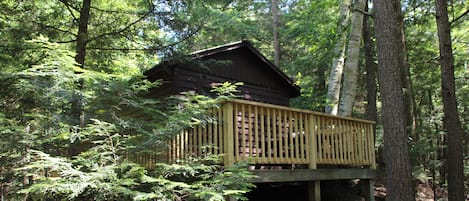Cabaña
Guides Cabin with Woodland View
Cabaña en un río con cocina y patio
Galería de fotos de Guides Cabin with Woodland View





Opiniones
10 de 10,
Excepcional
1 habitación1 baño4 personas65 metros cuadrados
Servicios principales
Explora la zona

Paul Smiths, NY
- Place, Brighton Town Hall6 min en auto
- Place, Paul Smiths College8 min en auto
- Place, Centro de interpretación de visitantes de Paul Smith's College8 min en auto
- Airport, Saranac Lake, NY (SLK-A. Regional Adirondack)19 min en auto
Habitaciones y camas
1 habitación (para 4 personas)
Habitación 1
1 sofá cama matrimonial
Habitación 2
1 cama Queen
1 baño
Baño 1
Excusado · Solo regadera
Ambientes
Deck o patio
Cocina
Área de comedor
Información de la propiedad
Guides Cabin with Woodland View
Located in the Lodge Buildinge it has its own entrances - so even though Guides is in what we call the lodge building there are no shared indoor spaces. It is very private but there is one adjoining wall with another unit. Situated about 300 feet from the lake. The main room contains a living area with a cast iron gas fireplace and sleeper sofa, a dining area, and a kitchen. Bedroom with queen bed. Full bathroom with shower, no tub. The east-facing covered deck of Guides has a lake view in the distance through the trees. In addition, the covered porch between the cabins is shared with Mrs. Otis and has a woodland and camp view.
Guides can be rented in combination with Mrs. Otis for a special reduced price. This combination would sleep a total of 4 people between two bedrooms, or up to a total of 8 people if the sleeper sofas are utilized.
The Great Room: The social retreat of an Adirondack Great Camp is the Great Room, a rustically grandiose meeting place for formal and informal activities. White Pine Camp's Great Room is available to guests at all times and provides a comfortable setting with furnishings typical of the era, including stick furniture, leather couches and decorative taxidermy. Firewood in the huge flagstone fireplace is always laid for guests to light at their leisure.
The Overlook: Under a canopy of cathedral pines and overlooking the Japanese Tea House and Osgood Pond is the Overlook. With its expansive vintage red tile patio, pergola, Adirondack furniture and fire pit, the Overlook is a popular spot for a lunch time picnic, late afternoon cocktails or an evening campfire with s'mores.
The Bowling Alley: Part of the Addison Mizner architectural design, the bowling alley was added to the game room in 1911. Yes, the set-your-own-pins bowling alley is still functioning and is much enjoyed by guests young and old. It also boasts a large stone fireplace, pool table and intimate back porch with incredible sunset views of Osgood Pond.
Japanese Tea House: Much coveted by the wealthy ladies of the Great Camps was a Japanese Tea House on an island. Olive White, wife of the original owner, was determined to have one as well. Today the Tea House is one of the most sought-after photo subjects in the Adirondacks. Our guests enjoy unlimited use of the Tea House island as a quiet getaway,
Guides can be rented in combination with Mrs. Otis for a special reduced price. This combination would sleep a total of 4 people between two bedrooms, or up to a total of 8 people if the sleeper sofas are utilized.
The Great Room: The social retreat of an Adirondack Great Camp is the Great Room, a rustically grandiose meeting place for formal and informal activities. White Pine Camp's Great Room is available to guests at all times and provides a comfortable setting with furnishings typical of the era, including stick furniture, leather couches and decorative taxidermy. Firewood in the huge flagstone fireplace is always laid for guests to light at their leisure.
The Overlook: Under a canopy of cathedral pines and overlooking the Japanese Tea House and Osgood Pond is the Overlook. With its expansive vintage red tile patio, pergola, Adirondack furniture and fire pit, the Overlook is a popular spot for a lunch time picnic, late afternoon cocktails or an evening campfire with s'mores.
The Bowling Alley: Part of the Addison Mizner architectural design, the bowling alley was added to the game room in 1911. Yes, the set-your-own-pins bowling alley is still functioning and is much enjoyed by guests young and old. It also boasts a large stone fireplace, pool table and intimate back porch with incredible sunset views of Osgood Pond.
Japanese Tea House: Much coveted by the wealthy ladies of the Great Camps was a Japanese Tea House on an island. Olive White, wife of the original owner, was determined to have one as well. Today the Tea House is one of the most sought-after photo subjects in the Adirondacks. Our guests enjoy unlimited use of the Tea House island as a quiet getaway,
Agrega fechas para ver los precios
Servicios
Cocina
Secadora
A/A
Gimnasio
Área exterior
Estacionamiento disponible
Propiedades similares
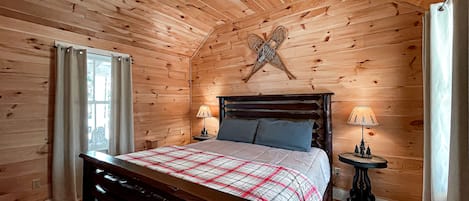
Longfellow a Traditional Cabin
Longfellow a Traditional Cabin
- Cocina
- Aire acondicionado
- Gimnasio
- Espacio al aire libre
9.8 de 10, Excepcional, (8 opiniones)
Reglas de la propiedad
Hora de inicio del check-in: 16:00
Edad mínima para rentar: 18
Hora límite del check-out: 10:30
Niños
Se permiten niños: edad mínima de 0 a 17 años
Eventos
Se permiten eventos
Weddings & private parties, Group parties
Mascotas
No se aceptan mascotas
Fumar
No se permite fumar
Información importante
Información importante
Podría aplicarse un cargo por persona extra, que varía según la política de la propiedad
Es posible que debas presentar una identificación oficial con fotografía y una tarjeta de crédito, una tarjeta de débito o hacer un depósito en efectivo en el check-in para cubrir cualquier gasto imprevisto
Las solicitudes especiales no se pueden garantizar. Están sujetas a disponibilidad al momento del check-in y pueden tener un costo extra
Se permite organizar fiestas y eventos
Nota del anfitrión: Weddings & private parties, Group parties
El anfitrión no indicó si hay detector de monóxido de carbono en la propiedad, por lo que se recomienda llevar uno portátil
El anfitrión indicó que hay un detector de humo en la propiedad
El equipamiento de seguridad de esta propiedad incluye extintor de incendios
Esta propiedad tiene espacios al aire libre, como balcones, patios y terrazas, que podrían no ser adecuados para niños; en caso de inquietudes, recomendamos que te comuniques con la propiedad antes de tu llegada para confirmar que puedas hospedarte en una habitación que se ajuste a tus necesidades.
Avisos importantes
Se recomienda acceder a este hospedaje en auto.
Información de la zona
Rainbow Lake
Esta cabaña se encuentra en la zona centro y en un río, en Rainbow Lake. Adirondack Artists Guild y The Waterhole son lugares culturales destacados, y algunos de los puntos de interés del área incluyen Carrusel Adirondack y Estación de ferrocarril panorámica de Saranac Lake. En la zona, puedes practicar actividades como kayaks y rafting, o disfrutar del aire libre mientras haces alpinismo y ciclismo.

Paul Smiths, NY
Qué hay cerca
- Brighton Town Hall - A 6 min en auto - 4.0 km
- Paul Smiths College - A 8 min en auto - 6.6 km
- The Great Lawn - A 8 min en auto - 6.6 km
- Centro de interpretación de visitantes de Paul Smith's College - A 8 min en auto - 7.6 km
- Upper Saint Regis Lake - A 10 min en auto - 10.9 km
Medios de transporte
Restaurantes
- Joan Weill Student Center - A 9 min en auto
- Bobcat Lounge - A 9 min en auto
- Donnelly's Ice Cream - A 17 min en auto
- Charlie's Inn - A 16 min en auto
- Adk Cavu Cafe - A 20 min en auto
Preguntas frecuentes
Acerca del anfitrión
Anfitrión: Tim Moody 518-327-3030
The Builders
At the turn of the twentieth century, much of the St. Regis Lakes area was owned by Paul Smith lumber baron, inn keeper, and raconteur. Many of Smith’s prominent hotel guests subsequently purchased lakefront property from Smith to build their own summer homes, or camps, as they came to be known. One such buyer was Archibald S. White, a prominent New York banker, and his socialite wife, Olive. The Whites purchased 35 acres covered with white and red pine trees overlooking what then was called Lake Osgood.
In 1907 White commissioned New York architect William Massarene to design his Adirondack camp, just a short boat ride from Paul Smith’s Hotel. Ben Muncil, the region’s unschooled master camp builder, was the contractor. White also hired interior designer and architect Addison Mizner to work on furnishings and decor and design several additions and alterations. White Pine Camp was one of Mizner’s first commissions. He went on to become one of America’s leading architects and the visionary behind the development of Boca Raton, Florida.
At the turn of the twentieth century, much of the St. Regis Lakes area was owned by Paul Smith lumber baron, inn keeper, and raconteur. Many of Smith’s prominent hotel guests subsequently purchased lakefront property from Smith to build their own summer homes, or camps, as they came to be known. One such buyer was Archibald S. White, a prominent New York banker, and his socialite wife, Olive. The Whites purchased 35 acres covered with white and red pine trees overlooking what then was called Lake Osgood.
In 1907 White commissioned New York architect William Massarene to design his Adirondack camp, just a short boat ride from Paul Smith’s Hotel. Ben Muncil, the region’s unschooled master camp builder, was the contractor. White also hired interior designer and architect Addison Mizner to work on furnishings and decor and design several additions and alterations. White Pine Camp was one of Mizner’s first commissions. He went on to become one of America’s leading architects and the visionary behind the development of Boca Raton, Florida.
Por qué eligió esta propiedad
The Camp
The camp that Massarene, Muncil and Mizner designed and built would be architecturally unique among the Great Camps of the Adirondacks. Its 20 original buildings included an owner’s cabin, dining hall, four or five sleeping cabins, two boat houses, a tennis house, bowling alley a Japanese tea house that would become one of the Adirondacks’ most iconic images. But unlike the heavy log style first developed by William West Durant or the ornate artistry associated with later Adirondack styles, White Pine Camp’s builders effected a more subtle rustic expression. Their “pre-modern” composition featured soaring roof lines, asymmetrical -shaped buildings, and the extensive use of dramatic, natural lighting. If windows are indeed the eyes of a home, White Pine Camp’s unusually shaped windows--in corners and clearstories--open every room to a kaleidoscopic array of natural light textures.
Another one of the builders’ innovations was the rough-milled siding developed by Muncil and Paul Smith’s millwright, Charles Nichols. It was a compromise between more traditional clapboard siding and the rustic slab siding typical of other Adirondack camps. Muncil and Nichols’ “brainstorm siding”, as they humorously referred to their innovation, soon became a common element of Adirondack architecture. Also known as “Adirondack siding”, it soon spread throughout the region and beyond.
In addition to its innovative architectural style, White Pine Camp’s designers surrounded their buildings with the most extensive landscape architecture of any Adirondack rustic estate to date. Its masonry walls, paths, bridges, flower plantings and lush rhododendron gardens create a medley of natural elements that embrace the camp’s grounds.
The camp that Massarene, Muncil and Mizner designed and built would be architecturally unique among the Great Camps of the Adirondacks. Its 20 original buildings included an owner’s cabin, dining hall, four or five sleeping cabins, two boat houses, a tennis house, bowling alley a Japanese tea house that would become one of the Adirondacks’ most iconic images. But unlike the heavy log style first developed by William West Durant or the ornate artistry associated with later Adirondack styles, White Pine Camp’s builders effected a more subtle rustic expression. Their “pre-modern” composition featured soaring roof lines, asymmetrical -shaped buildings, and the extensive use of dramatic, natural lighting. If windows are indeed the eyes of a home, White Pine Camp’s unusually shaped windows--in corners and clearstories--open every room to a kaleidoscopic array of natural light textures.
Another one of the builders’ innovations was the rough-milled siding developed by Muncil and Paul Smith’s millwright, Charles Nichols. It was a compromise between more traditional clapboard siding and the rustic slab siding typical of other Adirondack camps. Muncil and Nichols’ “brainstorm siding”, as they humorously referred to their innovation, soon became a common element of Adirondack architecture. Also known as “Adirondack siding”, it soon spread throughout the region and beyond.
In addition to its innovative architectural style, White Pine Camp’s designers surrounded their buildings with the most extensive landscape architecture of any Adirondack rustic estate to date. Its masonry walls, paths, bridges, flower plantings and lush rhododendron gardens create a medley of natural elements that embrace the camp’s grounds.
Qué distingue a esta propiedad
As a guest, you have your choice of 13 distinctive cabins and cottages with soaring roof lines, hand-built Adirondack-style furniture, stone fireplaces or wood stoves, and breathtaking views. Two cottages are pet-friendly, and most have private porches or patios.
Also, as a guest, you have total and unlimited access to all our facilities and activities.
Want to go fishing or boating? Just walk down to one of our two boathouses and grab a canoe, rowboat or kayak.
Want to hike? Head out on a trail right outside your door.
Want to swim? Enjoy an invigorating dip in the crystal-clear waters of Osgood Pond.
Like to bowl? You can do so in the vintage bowling alley used by the President himself... as long as you set your own pins.
And don't forget to bring a good book. White Pine Camp literally has dozens of indoor and outdoor hideaways to while away a lazy afternoon - be it by a roaring fire in the 'Great Room,' on a rustic bench in our Alpine garden, or in our iconic Japanese tea house on a tiny island accessed by a 300-foot wooden bridge.
Should you tear yourself away from camp, you'll find an entire smorgasbord of natural adventures. We are surrounded by the St. Regis Canoe Wilderness, with some of the most extensive paddling routes in the country. And, 'down the street' - our version of two miles - is Paul Smith's College, where you are welcome to enjoy the fitness center, café and Visitor Interpretive Center, the ultimate source on snowshoe, cross-country skiing, bird watching and back-country hiking.
Also, as a guest, you have total and unlimited access to all our facilities and activities.
Want to go fishing or boating? Just walk down to one of our two boathouses and grab a canoe, rowboat or kayak.
Want to hike? Head out on a trail right outside your door.
Want to swim? Enjoy an invigorating dip in the crystal-clear waters of Osgood Pond.
Like to bowl? You can do so in the vintage bowling alley used by the President himself... as long as you set your own pins.
And don't forget to bring a good book. White Pine Camp literally has dozens of indoor and outdoor hideaways to while away a lazy afternoon - be it by a roaring fire in the 'Great Room,' on a rustic bench in our Alpine garden, or in our iconic Japanese tea house on a tiny island accessed by a 300-foot wooden bridge.
Should you tear yourself away from camp, you'll find an entire smorgasbord of natural adventures. We are surrounded by the St. Regis Canoe Wilderness, with some of the most extensive paddling routes in the country. And, 'down the street' - our version of two miles - is Paul Smith's College, where you are welcome to enjoy the fitness center, café and Visitor Interpretive Center, the ultimate source on snowshoe, cross-country skiing, bird watching and back-country hiking.
Idiomas:
inglés
Anfitrión Premium
Se distingue por ofrecer una buena experiencia a sus huéspedes
Dinos cómo podemos mejorar nuestro sitioEnviar comentarios
